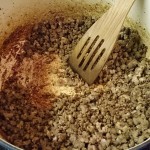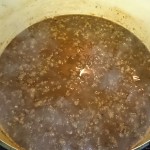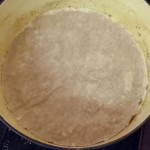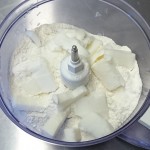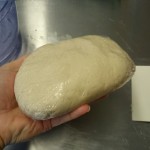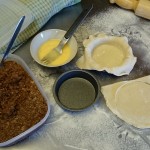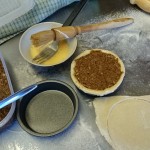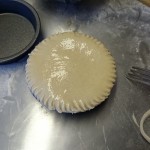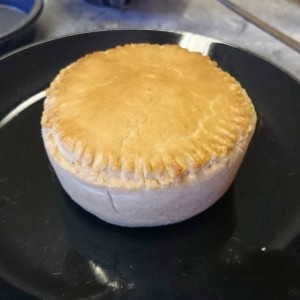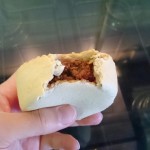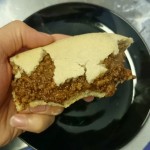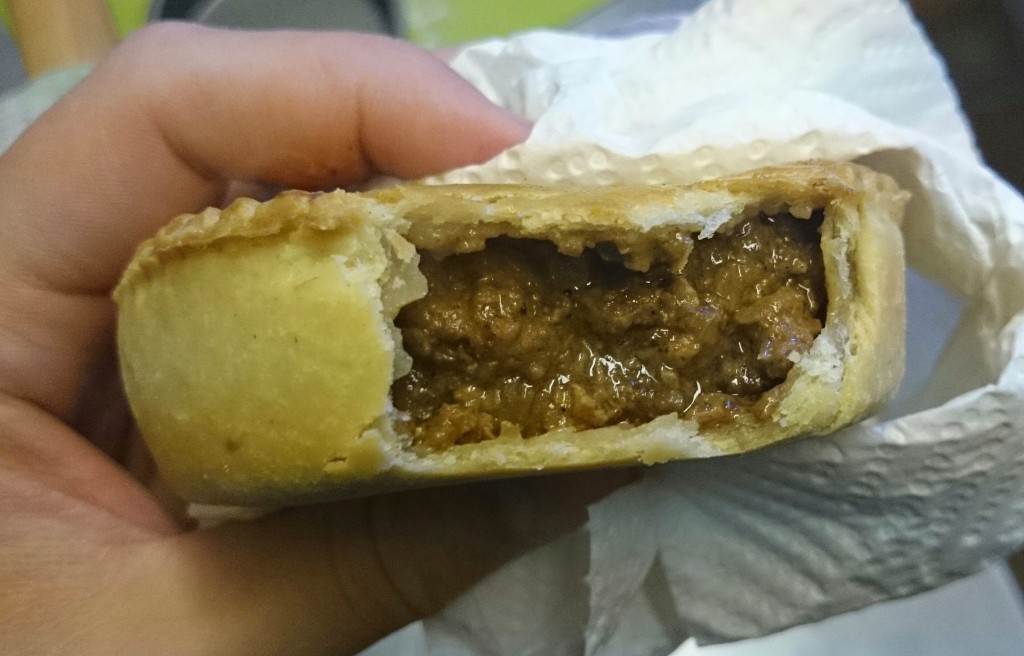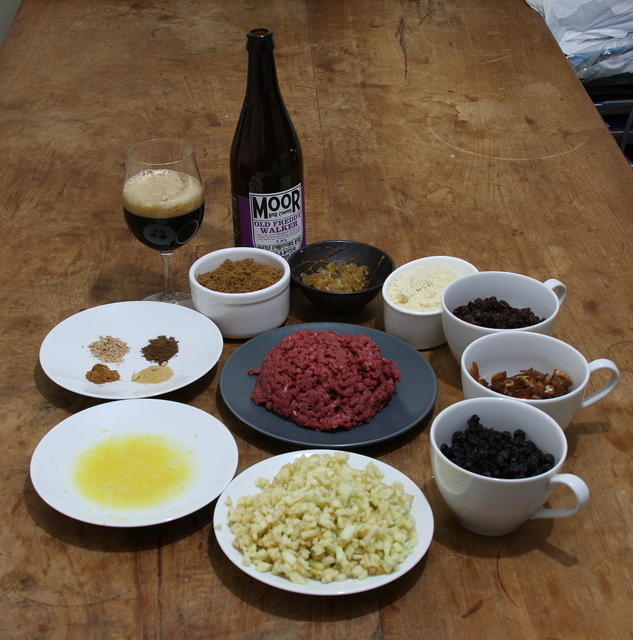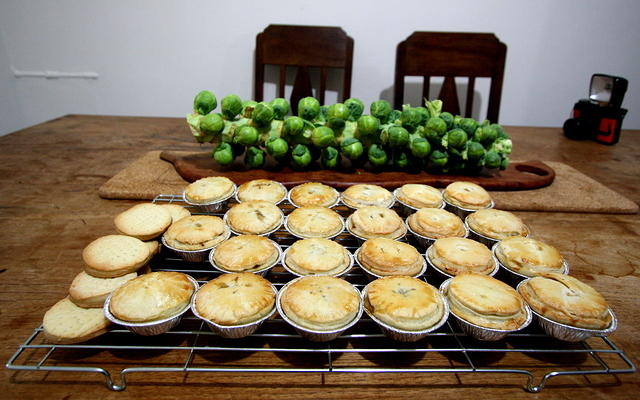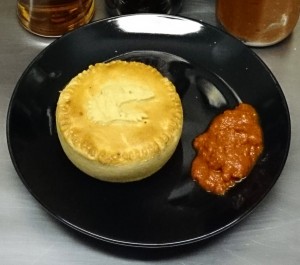 I’ve cooked with the Badger Poacher’s Choice before, amusing myself by combining it with pheasant in the Poacher’s Pheasant Stew. Pheasant is a bird much admired in the recipes of the Poacher’s Cookbook. In a similar “humourous” vein venison becomes a natural partner to the beer as well. I’m easily amused I suppose. To add my own twist to an idea that is certainly unlikely to be a new one I’m going to combine the ingredients and present them Aussie style, replicating – as best I can – the classic Australian bakery “meat pie“. The “meat” in a “meat pie” is infamously never specified; with the joke being “there aren’t many stray cats in a town with a good bakery”. In reality beef is the typical “meat” in question, although I don’t see why it shouldn’t be kangaroo… and if kangaroo then why not venison?
I’ve cooked with the Badger Poacher’s Choice before, amusing myself by combining it with pheasant in the Poacher’s Pheasant Stew. Pheasant is a bird much admired in the recipes of the Poacher’s Cookbook. In a similar “humourous” vein venison becomes a natural partner to the beer as well. I’m easily amused I suppose. To add my own twist to an idea that is certainly unlikely to be a new one I’m going to combine the ingredients and present them Aussie style, replicating – as best I can – the classic Australian bakery “meat pie“. The “meat” in a “meat pie” is infamously never specified; with the joke being “there aren’t many stray cats in a town with a good bakery”. In reality beef is the typical “meat” in question, although I don’t see why it shouldn’t be kangaroo… and if kangaroo then why not venison?
For reference here’s some photos I found of what look to me like the archetypal “Aussie Meat Pie”!
I did a fair bit of research into the creating of proper bakery meat pies, it turns out to be hard to pin down with most recipes more “homey” than “bakery”. I even asked my mum, who did some time in a bakery long ago when between-restaurants. Mum sent me some recommendations…
I am no pie cook but if I were to cook one at home I definitely wouldn’t use mince unless you mince some chuck or gravy beef yourself as the shop mince is definitely made from topside or similar and generally tough and inedible unless you get a good ‘fatty’ mix, you might have a good butcher! Otherwise use some well aged chuck (my preference) and dice it up with all the connective tissue and fatty bits intact. Make a really long slow cook casserole, I would add some roots and some good stock and brown the meat in seasoned flour. You could make a bit of a carbonnade but it needs to end up dark, caramelized and not too runny for pie. Pastry would be shortcrust on the bottom if you wish or no bottom and just a good lard pastry on top.
Since I’m using venison rather than beef I’ll coarsely mince it but add a bit of pork belly to increase the fat ratio – venison is a very lean meat. I’ve added a little veg to round it out, but it is meant to be a “meat pie” so I’ve kept veg to a minimum. The Poacher’s Choice is a rich and licorice-forward beer – which should complement the flavours from the fennel bulb and parsnip. Finally, I’d normally have a 10x reduced cubes of stock in the freezer but I’m all out at the moment – so rather than 50ml super-reduced real beef stock I’ve used a commercial stock cube… either would do, or use a normal beef-stock instead of the top-up water.
Filling Ingredients
- 1tbsp cooking oil
- 500g coarse-ground venison
- I minced my own using a 5mm plate, a good butcher should be happy to do this for you.
- 200g coarse-ground pork belly
- As above I ground my own – do remove the skin though, I find it doesn’t go though a mincer very well. You can put the skin in, the slow-cook will make it completely tender – but fine-chop it by hand similar to the veg.
- 50g fine-diced onion (~2mm dice)
- 50g fine-diced fennel bulb (~2mm dice)
- 50g fine-diced parsnip (~2mm dice)
- 2tbsp (15g) plain flour
- 1 beef stock cube (Or powder, good for approx half a litre reconstituted stock)
- ½tsp fresh-ground black pepper
- 2tbsp Worcestershire Sauce
- Almost every recipe I found for “Aussie meat pie” included Worcestershire Sauce, so here it is. Many included Vegemite too… but I don’t keep any around, can’t stand the stuff. (I did consider Promite… but no, it’s too precious to put in pie!)
- 500ml (1 bottle) Badger Poacher’s Choice
- Or rich ale of your choice – the Poacher’s Choice is described as “a smooth, dark ale enhanced by a touch of liquorice for spicy sweetness and damson for a soft, subtly fruity taste”.
- 200ml water (or just enough to just-submerge the meat)
Filling Method
The filling is basically a low-and-slow stew but made with ground rather than cubed meat – sort of like a good bolognese. First heat the cooking oil in an oven-proof pot/dish/casserole and thoroughly brown the ground meat. Add the diced vegetables and fry off for a couple of minutes before sprinkling in the plain flour and mixing in a little at a time until evenly distributed. Crumble in the stock cube, add the black pepper, Wostershire sauce, and pour in the bottle of beer. Finally add just enough water to bring the liquid level up to the meat level. Bring to a mere simmer, pop a cartouche of baking paper over the mix, and then with the lid on the pot put the whole thing in the oven at 120°C for about 5 hours.
After this time the meat should be tender and the gravy barely present. A taste of the meat proves it a little dry. But take it out of the oven and give it time… after a day in the fridge the meat content has moistened up.
Pastry Ingredients
Mum pointed me to the lard pastry in the Aussie cooking bible “The Cook’s Companion“, which she gave me a copy of many years ago. Stephanie Alexander says of this pastry: “This traditional pastry is from the north of England. It is very flexible and rather biscuit-like when cooked.” I’m not sure how specifically northern lard pastry is, but the description in general seems fit for an all-round pastry for a pie. So I’m using it for the top and the bottom. Many online recipes for “Aussie meat pies” use a puff for the top… which isn’t quite right, but it ought to be something a little flaky so perhaps a rough-puff would be more authentic.
- 200g Plain White Flour
- 200g Self Raising White Flour
- ½tsp salt
- 200g Lard (“room temp”)
- 180ml (approx) cold water
Rub together, or food-process, all ingredients except the water and form into a breadcrumb-like consistency. Then slowly combine in water to form a soft dough. You likely will not need all 180ml of water – I only needed about 150ml. Wrap the dough in some cling-film and pop in the fridge until needed, giving it at least 20 minutes.
SEE BELOW FOR IMPROVED BOTTOM-CRUST UPDATE!
Making Pies
A proper meat-pie should be single-serve sized but at least 10cm in diameter – they can be circular, oval, or even a round-cornered quadrilateral. A typical on-the-foot Aussie bakery lunch would be a pie and a “pusscake” (something sweet with custard in it – I’ll never forget being sent out for “pusscakes” by a paver I was labouring for one teenage summer, it was a vocabulary-expanding job). The non-sweet-toothed may opt for a second pie, or a sausage roll or pasty.
Preheat an oven to 200°C. Roll sufficient dough for bases and top out to a thickness of 1.5 to 2mm. Line pie trays, fill level with pie filling, seal top on with a little eggwash… fancy crimping is not typical, a back of a fork is over-doing it even. Lightly brush the top with eggwash for that shiny-golden effect. Appropriate sized & not-overfilled pies do not really need slits in top. Pop into the oven and bake for about 30 minutes… they’re done when golden brown and piping hot all the way through. Pies can be kept warm in the oven, but are best enjoyed right away. If you’re using circular pie dishes a great test is: it is done when golden on top and you can spin the pie in the dish!
Verdict
I’ve almost nailed it. The filling is inauthentically generous on the meat, a typical Aussie bakery pie has more thick gravy and less actual meat. This could probably be achieved by using a full 500ml of beef stock instead of the water & doubling the amount of flour – or post-thickening with cornflour. The crust is the main problem. It is good in that holds the pie together – I’ve made a pie that can be eaten in a hand. But it is just a little too brittle. As I got to the end of my pie it started to fall apart. Perhaps the secret is to pop some eggwhite in the dough instead of water. The top of the pie looks fantastic – but it isn’t quite authentic either, it lacks “flakiness” and perhaps I should have used a rough-puff. Finally, on the dimensions front it is just a little deeper than it should be in my opinion.
Authenticity aside… it’s a pretty good first attempt & a damn fine pie. It is very rich, you certainly don’t want it to be any larger than it is. The Poacher’s Choice flavour comes through but doesn’t dominate and the meat has resistance but is not chewy or dry. Traditionally a Aussie meat pie is enjoyed with plenty of dead horse – but I’m enjoying mine with a slathering of my home-made oaky-beer chilli sauce!
[UPDATE] Aussie Bottom Crust
After some research I’ve got a recipe for the bottom-crust that does the job. It’s based on this information here: Villa Tempest: On Traditional Australian Pie Base
I’m using the 3:2:1 flour:shortening:liquid ratio, specifically: ingredients all at room temperature (~20°C – a bit of a struggle in British winter!):
- 2 eggs (120g)
- 240g butter
- 360g flour
Method: weigh eggs into a food processor (with metal or, preferably, plastic blade attachment) and then add twice their weight in butter. It is important that this is done at “room temperature”. Turn the food processor on and blitz eggs and butter for 30 seconds to loosely combine. Add a third of the flour (120g) and then blitz this for at least 5 minutes until a smooth and even textured paste is formed. While the processor is running gradually add the remaining flour – the dough should form into a ball in your food processor.
Wrap flattened ball of dough in cling-film and pop into the fridge for a couple of hours, or longer – until required.
When the dough is required remove from fridge, cut off just enough to make a batch of pies, and pop remaining dough back in fridge until you need it. Initially this dough will be very solid – but it should be rollable, if not it might need 30 minutes to warm up. Roll dough out to 1mm to 1.5mm thickness on a cool floured surface. Let rolled out dough rest for a couple of minutes and then use it to line the tins… recipe then continues as above. Top crust is still the lardy one above, but I think a rough-puff might be better. (That’ll be the next update!)
I was able to eat this whole pie and the improved bottom crust didn’t split or break at all.







